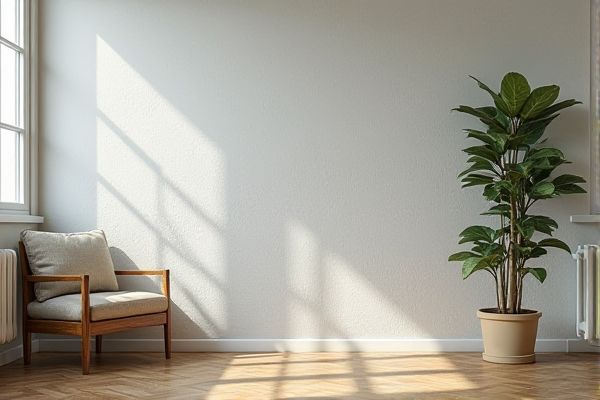
Waterproof paint creates a protective coating that repels water from surfaces, while a moisture barrier acts as a physical layer preventing moisture from penetrating walls or floors. To understand which option best suits Your needs for damp-proofing and protection, keep reading the rest of the article.
Table of Comparison
| Feature | Waterproof Paint | Moisture Barrier |
|---|---|---|
| Primary Function | Prevents water penetration on surfaces | Blocks moisture movement through walls or floors |
| Material Type | Liquid coating, often acrylic or elastomeric | Sheet membranes, vapor barriers, or sealants |
| Application Areas | Exterior walls, roofs, concrete surfaces | Foundation walls, crawl spaces, basements |
| Installation | Brushed, rolled, or sprayed onto surface | Applied as sheets or membranes beneath or inside structures |
| Effectiveness | Resists liquid water, not always vapor | Blocks moisture vapor and liquid effectively |
| Durability | Moderate; may require reapplication over time | High; designed for long-term moisture control |
| Cost | Generally lower initial cost | Higher cost due to materials and installation |
| Typical Use | Surface water protection and minor dampness | Foundation moisture control and vapor prevention |
Understanding Waterproof Paint: Key Features
Waterproof paint contains polymers and resins that create a durable, water-resistant coating preventing water penetration on surfaces like walls and wood. Its key features include flexibility to withstand surface expansion, resistance to mildew and algae growth, and ease of application without specialized tools. Unlike moisture barriers, waterproof paint primarily protects against surface water exposure rather than blocking vapor transmission through building materials.
What is a Moisture Barrier?
A moisture barrier is a specialized material designed to prevent water vapor from penetrating walls, floors, and ceilings, protecting building structures from mold, rot, and deterioration. Unlike waterproof paint, which primarily repels liquid water on surfaces, moisture barriers provide a continuous shield against moisture migration through porous materials. Common moisture barriers include polyethylene sheets, vapor-retardant paints, and membranes that enhance long-term durability and indoor air quality.
How Waterproof Paint Works
Waterproof paint works by creating a protective layer that prevents water from penetrating surfaces, using polymers and resins to form a seamless, water-repellent coating. Unlike moisture barriers, which act as physical shields to block moisture movement entirely, waterproof paint adapts to surface texture and provides flexibility to resist cracks and peeling. You can enhance the durability of outdoor walls and prevent water damage effectively by choosing the right waterproof paint based on its water resistance rating and surface compatibility.
How Moisture Barriers Function
Moisture barriers function by creating an impermeable layer that prevents water vapor from penetrating walls and floors, effectively reducing the risk of mold and structural damage. Unlike waterproof paint that offers surface-level protection by repelling liquid water, moisture barriers work at a deeper level to control humidity and vapor transmission within building materials. This critical function ensures long-term durability and indoor air quality by maintaining dry, moisture-controlled environments.
Waterproof Paint vs Moisture Barrier: Major Differences
Waterproof paint forms a protective coating that repels water on surfaces, ideal for preventing water penetration on walls and decks. A moisture barrier, typically a physical membrane like plastic sheeting or specialized wraps, blocks water vapor and liquid from passing through building structures. Understanding these major differences helps you choose between a surface-level sealant (waterproof paint) and an integral vapor block (moisture barrier) depending on your project's moisture control needs.
Pros and Cons of Waterproof Paint
Waterproof paint provides a protective coating that repels water and prevents surface damage, making it ideal for exterior walls and concrete surfaces exposed to rain. It is easy to apply and cost-effective but may not fully stop moisture migration through walls, which can lead to trapped dampness and mold growth over time. Unlike moisture barriers, waterproof paint offers limited vapor resistance and is less effective in environments with high humidity or direct water pressure.
Advantages and Drawbacks of Moisture Barriers
Moisture barriers offer superior protection by preventing water vapor from penetrating walls and floors, which helps in reducing mold growth and structural damage. However, they can trap moisture if improperly installed, potentially leading to condensation issues and deterioration of building materials. You must weigh the long-term durability and installation costs against the risk of moisture accumulation when choosing between waterproof paint and moisture barriers.
Best Applications for Waterproof Paint
Waterproof paint is best applied on surfaces exposed to light water contact, such as exterior walls, bathroom walls, and basements, providing a protective layer that repels water and prevents surface damage. Unlike moisture barriers, waterproof paint allows surfaces to breathe, reducing the risk of trapped moisture and mold growth, ideal for areas with occasional dampness but not constant water pressure. Your choice of waterproof paint suits environments where resistance to splashes, rain, and humidity is necessary without requiring heavy-duty moisture resistance.
When to Choose a Moisture Barrier
Choose a moisture barrier when your goal is to prevent water vapor from penetrating walls or floors, especially in areas prone to high humidity or condensation like basements and crawl spaces. Unlike waterproof paint, which primarily repels liquid water on surfaces, moisture barriers create a continuous, impermeable layer that stops moisture at its source. Protecting your home's structural integrity and indoor air quality heavily depends on selecting the correct solution for moisture control.
Which is Right for Your Project: Final Comparison
Waterproof paint provides a protective coating that repels water on surfaces, ideal for exterior walls and areas exposed to rain. Moisture barriers, typically installed within walls or under flooring, prevent water vapor from penetrating structural materials, critical in basements or crawl spaces. Your project benefits from waterproof paint when surface protection is needed, but moisture barriers are essential for comprehensive moisture control and preventing long-term damage.
 homyna.com
homyna.com